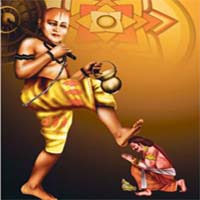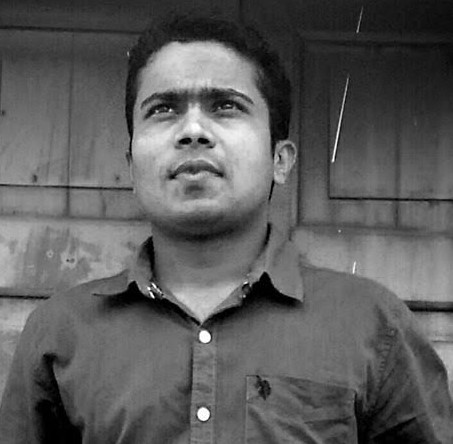Vanshree Vankar
 Pandurangji Gosavi, my grandfather, is a freedom fighter. 95 years old, he was born in 1924. He has spent his whole life in Sewagram. Sewagram is the same place where Gandhi stayed from 1936 to 1948 and this is the same place where his magnificent ashram is. It won’t be an exaggeration to say that the entire Wardha district has been greatly influenced by Gandhian ideology. In fact, the neighboring districts recognize Wardha as a Gandhian district. From architecture to aesthetics to the overall outlay of the city has a great influence of Gandhian thought on it.
Pandurangji Gosavi, my grandfather, is a freedom fighter. 95 years old, he was born in 1924. He has spent his whole life in Sewagram. Sewagram is the same place where Gandhi stayed from 1936 to 1948 and this is the same place where his magnificent ashram is. It won’t be an exaggeration to say that the entire Wardha district has been greatly influenced by Gandhian ideology. In fact, the neighboring districts recognize Wardha as a Gandhian district. From architecture to aesthetics to the overall outlay of the city has a great influence of Gandhian thought on it.
Sewagram ashram is a happening place with frequent seminars and workshops. Till today all those routines and traditions are followed by the ashram which was started by Gandhi in 1930s. Many scholars, thinkers, social workers, activists, and academicians pay their visit to the ashram every year. From political leaders to artists and celebrities from season to season have been coming here. While some come and go, others stay here for a while so as to experience a Gandhian way of life. All the information one could get from different sources about Sewagram is about Gandhi and Gandhian thoughts, but this knowledge about Sewagram village would be meaningless and colonial if one ignores the life and thoughts of the villagers of this village. Hence it becomes very crucial to know the people of Sewagram to understand Sewagram. This perspective of the people who lived in the vicinity of Gandhi can only be gathered from the people themselves and not from any theorist or academician writing from her desk.
The real village which can also be called as a vasti (hamlet) is merely 200 meters away from the Ashram. As soon as one enters the vasti one can find a man in a standing position with the constitution in his one hand and the other pointing forward as if he is asking all the Dalit population of this hamlet to break their shackles and march towards dignity and self-respect. Given this description, a socially aware person of this country could easily recognize that this person is none other than Dr. B. R. Ambedkar. And just as the case with other slums, hamlets and cities, this statue of Dr. Ambedkar is built from the contributions of the people themselves. Each and every statue of Babasaheb in this country has got a history behind it and so has this statue.
Though my grandfather is 95 years old, his age is not reflected in his personality. He is 6 feet tall and still walks in an upright posture and his personality reflects his thoughts which can be said to be his source of energy. The government of India has honored and recognized him as a freedom fighter and he has also received an award from the President of India too. He still walks with pride with his shabnam (khadi) bag on his shoulders. This ‘shabnam bag’ on his shoulders can best reflect the saying that a ‘book can’t be judged by its cover’. His khadi bag and his thoughts do not go hand in hand which he himself might have never realized. This being a fact, though he was brought up in the ashram, he might be the first person who rejected Gandhian ideology and embraced Ambedkar.

My grandfather lived with and had constant interaction with Gandhi, Kasturba, Nehru, Rajendra Prasad, Jayaprakash Narayan, Indira Gandhi, Jamnalal Bajaj and many more. But while narrating his experience with Ambedkar and his historical visit, my grandfather goes into another world. He glows like a lamp as if he is so special to have seen Ambedkar in person, which was just a dream for millions of others. Being born and brought up in a Dalit family, it was their routine to take care of the landlord’s cows and buffalos and to take them for grazing. Once, a shay stopped near him and they asked him the way to ashram. The person in that shay was none other than Jayprakash Narayan. It was this incident that brought my grandfather close to the ashram and from there began his training (talim). To toil was his training. It included to yarn spinning on the wheel, to become a volunteer, to organize prayer meeting etc. This was the routine of the ashram. He also received an award and honor from Rajendra Prasad for a competition of yarn spinning for the longest duration.
His life took a sharp turn when he first met Dr. Ambedkar. On 1st May 1936, Gandhi invited Babasaheb to visit him. Respecting his invitation, Babasaheb paid a visit to Sewagram. But before going to the ashram he went to speak with the people in the village. The news ‘Babasaheb is coming’ spread like a wildfire in the village and in a short period of time people gathered to see the person they had only heard till now. My grandfather says that he had thought when Babasaheb would come to his village, he would comfort their grief and give them sympathy. But what happened is a different story or in fact a contrasting story. Babasaheb stepped out from his shay and walked towards the people where they were standing. As this was an unplanned visit nothing was arranged. There was a neem tree and in front of that, there was a temple of Vitthal. Babasaheb sat on a stone in front of this temple. Looking at the people he said, “Send your children to school, this is not my request but an appeal to you, this battle is not easy, we will have to fight hard, leave this life of helplessness and live with self-respect. You will have to build your own life, nobody here will help you”. My grandfather says that Babasaheb spoke in a sharp tone, his clothes were neat and clean, his posture had confidence, his words were directly impacting the minds of people and a new reality was opening up.
Here one must have an idea of the historical events which could give us a clear picture of the work of Ambedkar and Gandhi as regards to Dalits of this country. From 1885 when the Congress was established, it had two wings, one focusing on political reformation and the other focusing on social reformation. Gradually, the wing for social reforming was dissolved by the upper caste members of the Congress. Tilak was one of them. From then till 1920s no one attempted to review the social reform wing. After the death of Tilak in 1920, all the strings of Congress were in the hands of Gandhi but it was only after the three Round Table Conferences and when Ramsay Macdonald in 1932 declared the Communal Award that the roots of Gandhi were shaken to the core. He realized that he can no more ignore this huge chunk of the population which he termed as ‘Harijans’. After he went on to fast at Yerwada jail in Pune and Babasaheb had to compromise to accept Reservation in the place of Separate Electorate, Gandhi knew that though he had forced Ambedkar to sign the contract, and he cannot escape the question of Dalits, whose leader, according to him, was against those very scriptures from where the notion of caste emerged. And if Ambedkar rejected these notions then Varnashram would fall which placed Gandhi at the higher level and Dalits at the bottom. Gandhi was aware and had been openly saying how Ambedkar was a threat to his religion. This was the political context and the discourse when Dr. Ambedkar came to visit Gandhi.
This interaction with Babasaheb impacted grandfather’s thoughts to a great extent but he still continued his training and routine at the ashram as this had been his way of life for quite a long period of time but a volcano called Ambedkar was erupting in his mind. Mr. Gandhi’s ideology was to go on the path of charity, service, and sympathy. On the other hand, Dr. Ambedkar’s move was to go on the path of self-respect, annihilation of caste and Buddha. Babasaheb strongly opposed Gandhi’s ideology of donation and sympathies. It was during this period that my grandfather started critically analyzing the realities around him. Now he was aware of the difference between ‘elimination of caste’ and ‘annihilation of caste’. Now he understood why Ambedkar had rejected Jayprakash Narayan’s ‘charitable trust’ concept. Due to this ideological change, my grandfather threw out the ‘Harijan Peti (donation box for harijan) in the ashram and installed a new box there and named it ‘Danapeti’ (donation box). Now he was turning towards education from the training of ashram.
A person who grew up in the Gandhian atmosphere from his childhood, today refuses sympathy and accepts the way of self-respect. This change was brought about by those simple words of Babasaheb. That one incident changed the perspective of the people who were till now looking at themselves through someone else’s mirror. Babasaheb broke that mirror. Self-respect and dignity were new words for them. It was this ‘Swaraj’ that they were looking for. Sewagram was reborn after this event. In 1956, it was at Deeksha Bhoomi that Babasaheb introduced Buddha’s Dhamma to the Dalits of India and here my grandfather at Sewagram also did a revolution but on a different scale. After hearing that Babasaheb along with his lakhs of followers had taken refuge to Buddhism. My grandfather, at midnight, replaced the statue of Vitthal in the temple with Buddha’s. To replace a god’s idol in the temple in a village setting is not an easy task even today and hence for my grandfather and for the whole Dalit community in Sewagram this was not less than a revolution. The temple which never raised the consciousness of these people till date, today stands as a vihara which is also being constructed as a library. This is nothing less than the first step of Sewagram towards Enlightenment. The village is still known as Gandhi’s place across the world, but it’s Babasaheb who resides inside the people of this village and not Gandhi. This is mentioned nowhere!
The vihara which was a temple till 1956, is now the center of study for the children of the village. The stone on which Babasaheb sat is still there today and is like a heritage for the villagers. They gave it the fence of love. The stone still gives inspiration and strength to the people of not only the village but also outsiders who come to visit. And even today, every time my grandfather is asked to tell his story, he is always ready for it. His story starts with Gandhi and ends at Dr. Ambedkar.
From Empathy … Towards Self-respect…!!
From Training… Towards Education… !!
From Gandhi … Towards Ambedkar .. !!
~~~
Vanshree Vankar is a student of Dalit & Tribal Studies and Action at Tata Institute of Social Sciences (TISS), Mumbai.










